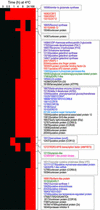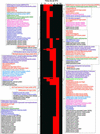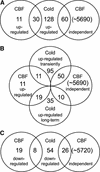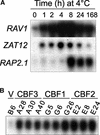Arabidopsis transcriptome profiling indicates that multiple regulatory pathways are activated during cold acclimation in addition to the CBF cold response pathway
- PMID: 12172015
- PMCID: PMC151458
- DOI: 10.1105/tpc.003483
Arabidopsis transcriptome profiling indicates that multiple regulatory pathways are activated during cold acclimation in addition to the CBF cold response pathway
Abstract
Many plants, including Arabidopsis, increase in freezing tolerance in response to low, nonfreezing temperatures, a phenomenon known as cold acclimation. Previous studies established that cold acclimation involves rapid expression of the CBF transcriptional activators (also known as DREB1 proteins) in response to low temperature followed by induction of the CBF regulon (CBF-targeted genes), which contributes to an increase in freezing tolerance. Here, we present the results of transcriptome-profiling experiments indicating the existence of multiple low-temperature regulatory pathways in addition to the CBF cold response pathway. The transcript levels of approximately 8000 genes were determined at multiple times after plants were transferred from warm to cold temperature and in warm-grown plants that constitutively expressed CBF1, CBF2, or CBF3. A total of 306 genes were identified as being cold responsive, with transcripts for 218 genes increasing and those for 88 genes decreasing threefold or more at one or more time points during the 7-day experiment. These results indicate that extensive downregulation of gene expression occurs during cold acclimation. Of the cold-responsive genes, 48 encode known or putative transcription factors. Two of these, RAP2.1 and RAP2.6, were activated by CBF expression and thus presumably control subregulons of the CBF regulon. Transcriptome comparisons indicated that only 12% of the cold-responsive genes are certain members of the CBF regulon. Moreover, at least 28% of the cold-responsive genes were not regulated by the CBF transcription factors, including 15 encoding known or putative transcription factors, indicating that these cold-responsive genes are members of different low-temperature regulons. Significantly, CBF expression at warm temperatures repressed the expression of eight genes that also were downregulated by low temperature, indicating that in addition to gene induction, gene repression is likely to play an integral role in cold acclimation.
Figures










Similar articles
-
Roles of the CBF2 and ZAT12 transcription factors in configuring the low temperature transcriptome of Arabidopsis.Plant J. 2005 Jan;41(2):195-211. doi: 10.1111/j.1365-313X.2004.02288.x. Plant J. 2005. PMID: 15634197
-
CBF-dependent and CBF-independent regulatory pathways contribute to the differences in freezing tolerance and cold-regulated gene expression of two Arabidopsis ecotypes locally adapted to sites in Sweden and Italy.PLoS One. 2018 Dec 5;13(12):e0207723. doi: 10.1371/journal.pone.0207723. eCollection 2018. PLoS One. 2018. PMID: 30517145 Free PMC article.
-
Circadian clock-associated 1 and late elongated hypocotyl regulate expression of the C-repeat binding factor (CBF) pathway in Arabidopsis.Proc Natl Acad Sci U S A. 2011 Apr 26;108(17):7241-6. doi: 10.1073/pnas.1103741108. Epub 2011 Apr 6. Proc Natl Acad Sci U S A. 2011. PMID: 21471455 Free PMC article.
-
[Arabidopsis CBF1 in plant tolerance to low temperature and drought stresses].Yi Chuan. 2004 May;26(3):394-8. Yi Chuan. 2004. PMID: 15640027 Review. Chinese.
-
Gene Regulatory Networks Mediating Cold Acclimation: The CBF Pathway.Adv Exp Med Biol. 2018;1081:3-22. doi: 10.1007/978-981-13-1244-1_1. Adv Exp Med Biol. 2018. PMID: 30288701 Review.
Cited by
-
OsTZF1, a CCCH-tandem zinc finger protein, confers delayed senescence and stress tolerance in rice by regulating stress-related genes.Plant Physiol. 2013 Mar;161(3):1202-16. doi: 10.1104/pp.112.205385. Epub 2013 Jan 7. Plant Physiol. 2013. PMID: 23296688 Free PMC article.
-
Posttranslational regulation of multiple clock-related transcription factors triggers cold-inducible gene expression in Arabidopsis.Proc Natl Acad Sci U S A. 2021 Mar 9;118(10):e2021048118. doi: 10.1073/pnas.2021048118. Proc Natl Acad Sci U S A. 2021. PMID: 33649234 Free PMC article.
-
A temperature induced lipocalin gene from Medicago falcata (MfTIL1) confers tolerance to cold and oxidative stress.Plant Mol Biol. 2015 Apr;87(6):645-54. doi: 10.1007/s11103-015-0304-3. Epub 2015 Mar 6. Plant Mol Biol. 2015. PMID: 25744207
-
Cold priming uncouples light- and cold-regulation of gene expression in Arabidopsis thaliana.BMC Plant Biol. 2020 Jun 18;20(1):281. doi: 10.1186/s12870-020-02487-0. BMC Plant Biol. 2020. PMID: 32552683 Free PMC article.
-
De novo sequencing and transcriptome analysis of the desert shrub, Ammopiptanthus mongolicus, during cold acclimation using Illumina/Solexa.BMC Genomics. 2013 Jul 18;14:488. doi: 10.1186/1471-2164-14-488. BMC Genomics. 2013. PMID: 23865740 Free PMC article.
References
-
- Abler, M.L., and Green, P.L. (1996). Control of mRNA stability in higher plants. Plant Mol. Biol. 32, 63–78. - PubMed
-
- Adamska, I. (1997). ELIPs: Light induced stress proteins. Physiol. Plant. 100, 794–805.
-
- Baker, S.S., Wilhelm, K.S., and Thomashow, M.F. (1994). The 5′-region of Arabidopsis thaliana cor15a has cis-acting elements that confer cold-, drought- and ABA-regulated gene expression. Plant Mol. Biol. 24, 701–713. - PubMed
-
- Ciardi, J.A., Deikman, J., and Orzolek, M.D. (1997). Increased ethylene synthesis enhances chilling tolerance in tomato. Physiol. Plant. 101, 333–340.
Publication types
MeSH terms
Substances
LinkOut - more resources
Full Text Sources
Other Literature Sources
Molecular Biology Databases

